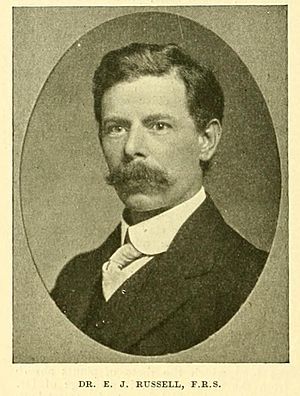E. John Russell facts for kids
Quick facts for kids
Sir
Edward John Russell
|
|
|---|---|
 |
|
| Born | 31 October 1872 Frampton on Severn, Gloucestershire, England
|
| Died | 12 July 1965 (aged 92) |
| Nationality | British |
| Alma mater |
|
| Scientific career | |
| Fields | Chemistry |
Sir Edward John Russell (born October 31, 1872 – died July 12, 1965) was a very important British scientist. He studied soil and how it helps plants grow. From 1912 to 1943, he was the director of the Rothamsted Experimental Station. This is a famous place where scientists research farming.
Sir Edward also helped start a group called the Imperial Agricultural Bureaux. This group later became the Commonwealth Agricultural Bureaux. Its main goal was to share new farming ideas and information around the world.
Contents
Early Life and Education
Edward John Russell was born in Frampton-on-Severn, England. His father was a reverend and a schoolmaster. The family moved to Birmingham in 1885, and then to London a year later.
Edward studied at several universities. He attended University College of Wales, Aberystwyth and the Victoria University of Manchester. In 1902, he earned his Doctor of Science degree in chemistry from the University of London.
His Work with Soil and Plants
Sir Edward began his career teaching chemistry in Manchester. From 1892 to 1907, he led the chemistry department at the South Eastern Agricultural College. He then joined Rothamsted Experimental Station in 1907. There, he worked as a soil chemist.
In 1913, he became the director of Rothamsted. He focused on understanding soil chemistry and how plants get their food from the soil. He hired a famous statistician, R A Fisher, in 1919. Fisher helped use math to make farming experiments better.
During World War I, Sir Edward helped the government with food production. For his important work, he received an OBE award in 1918. He was also knighted in 1922, which means he was given the title "Sir."
Sharing Farming Knowledge
Sir Edward was very concerned that scientists around the world weren't sharing enough information about farming. He believed that sharing knowledge could help everyone grow more food. This led him to create the Imperial Agricultural Bureaux. This organization made it easier for countries to exchange research and ideas about agriculture.
He was also the president of the Geographical Association in 1923. Later, he was president of the British Association from 1948 to 1949.
Family and Legacy
Sir Edward married Elnor Oldham in 1903. They had six children together. One of their sons, Walter, also became a soil-physicist at Rothamsted, following in his father's footsteps.
Sir Edward John Russell passed away on July 12, 1965. He is buried with his wife in the churchyard of St Nicholas in Harpenden. His work greatly improved our understanding of soil and helped farmers worldwide.

